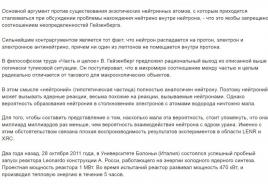Oxidation of calcium. Calcium and its characteristics
CALCIUM (Latin Calcium), Ca, chemical element of group II of short form (2nd group of long form) of the periodic system; refers to alkaline earth metals; atomic number 20; atomic mass 40.078. There are 6 stable isotopes in nature: 40 Ca (96.941%), 42 Ca (0.647%), 43 Ca (0.135%), 44 Ca (2.086%), 46 Ca (0.004%), 48 Ca (0.187%); artificially obtained radioisotopes with mass numbers 34-54.
Historical reference. Many natural calcium compounds were known in ancient times and were widely used in construction (for example, gypsum, lime, marble). Metallic calcium was first isolated by G. Davy in 1808 during the electrolysis of a mixture of CaO and HgO oxides and the subsequent decomposition of the formed calcium amalgam. The name comes from the Latin calx (genitive calcis) - lime, soft stone.
Prevalence in nature... The calcium content in the earth's crust is 3.38% by weight. Due to its high chemical activity, it does not occur in a free state. The most common minerals are anorthite Ca, anhydrite CaSO 4, apatite Ca 5 (PO 4) 3 (F, Cl, OH), gypsum CaSO 4 2H 2 O, calcite and aragonite CaCO 3, perovskite CaTiO 3, fluorite CaF 2, scheelite CaWO 4 . Calcium minerals are found in sedimentary (eg limestone), igneous and metamorphic rocks. Calcium compounds are found in living organisms: they are the main components of vertebrate bone tissues (hydroxyapatite, fluorapatite), coral skeletons, shells of mollusks (calcium carbonate and phosphates), etc. The presence of Ca 2+ ions determines the hardness of water.
Properties... The configuration of the outer electron shell of the calcium atom is 4s 2; in compounds, it exhibits an oxidation state of +2, rarely +1; Pauling electronegativity 1.00, atomic radius 180 pm, radius of the Ca 2+ ion 114 pm (coordination number 6). calcium is a silvery white soft metal; up to 443 ° С, the modification with a cubic face-centered crystal lattice is stable, above 443 ° С - with a cubic body-centered lattice; t pl 842 ° C, t bp 1484 ° C, density 1550 kg / m 3; thermal conductivity 125.6 W / (m · K).
Calcium is a metal of high chemical activity (stored in hermetically sealed vessels or under a layer of mineral oil). Under normal conditions, it easily interacts with oxygen (calcium oxide CaO is formed), when heated - with hydrogen (CaH 2 hydride), halogens (calcium halides), boron (CaB 6 boride), carbon (CaC 2 calcium carbide), silicon (Ca silicides 2 Si, CaSi, CaSi 2, Ca 3 Si 4), nitrogen (nitride Ca 3 N 2), phosphorus (phosphides Ca 3 P 2, CaP, CaP 5), chalcogenes (chalcogenides of composition CaX, where X is S, Se, Those). Calcium interacts with other metals (Li, Cu, Ag, Au, Mg, Zn, Al, Pb, Sn, etc.) to form intermetallic compounds. Metallic calcium interacts with water to form calcium hydroxide Ca (OH) 2 and H 2. Reacts vigorously with most acids to form the corresponding salts (for example, calcium nitrate, calcium sulfate, calcium phosphates). It dissolves in liquid ammonia to form a dark blue, metallic solution. When ammonia evaporates, ammonia is released from such a solution. Calcium gradually reacts with ammonia to form the amide Ca (NH 2) 2. Forms various complex compounds, the most important are complexes with oxygen-containing polydentate ligands, for example, Ca complexonates.
Biological role... Calcium is a biogenic element. The daily human need for calcium is about 1 g. In living organisms, calcium ions are involved in the processes of muscle contraction, transmission of nerve impulses.
Receiving... Metallic calcium is obtained by electrolytic and metallothermic methods. The electrolytic method is based on the electrolysis of molten calcium chloride with a touch cathode or liquid copper-calcium cathode. From the resulting copper-calcium alloy, calcium is distilled off at a temperature of 1000-1080 ° C and a pressure of 13-20 kPa. The metallothermal method is based on the reduction of calcium from its oxide with aluminum or silicon at 1100-1200 ° C. This forms calcium aluminate or silicate, as well as gaseous calcium, which is then condensed. World production of calcium compounds and materials containing calcium, about 1 billion tons / year (1998).
Application... Calcium is used as a reducing agent in the production of many metals (Rb, Cs, Zr, Hf, V, etc.). Calcium silicides, as well as calcium alloys with sodium, zinc and other metals are used as deoxidizers and desulfurizers of some alloys and oil, to purify argon from oxygen and nitrogen, and in electric vacuum devices as a gas absorber. Chloride CaCl 2 is used as a desiccant in chemical synthesis, gypsum is used in medicine. Calcium silicates are the main components of cement.
Lit .: Rodyakin V.V. Calcium, its compounds and alloys. M., 1967; Spitsyn V.I., Martynenko L.I. Inorganic chemistry. M., 1994. Part 2; Inorganic Chemistry / Edited by Yu. D. Tretyakov. M., 2004.Vol. 2.
L. N. Komissarova, M. A. Ryumin.
Calcium history
Calcium was discovered in 1808 by Humphrey Davy, who, by electrolysis of slaked lime and mercury oxide, obtained calcium amalgam, as a result of the process of distilling mercury from which the metal remained, which received the name calcium. In latin limesounds like calx, it was this name that was chosen by the English chemist for the open substance.
Calcium is an element of the main subgroup II of group IV of the periodic system of chemical elements of D.I. Mendeleev, has an atomic number of 20 and an atomic mass of 40.08. The accepted designation is Ca (from Latin - Calcium).
Physical and chemical properties
Calcium is a reactive, soft, silvery-white alkali metal. Due to the interaction with oxygen and carbon dioxide, the metal surface grows dull, therefore calcium needs a special storage mode - a tightly closed container in which the metal is poured with a layer of liquid paraffin or kerosene is mandatory.
Calcium is the most famous of the trace elements necessary for a person, the daily requirement for it is from 700 to 1500 mg for a healthy adult, but it increases during pregnancy and lactation, this must be taken into account and calcium should be obtained in the form of preparations.

Being in nature
Calcium has a very high chemical activity, therefore it does not occur in nature in its free (pure) form. Nevertheless, it is the fifth most common in the earth's crust, in the form of compounds it is found in sedimentary (limestone, chalk) and rocks (granite), a lot of calcium contains anorite feldspar.
In living organisms, it is widespread enough, its presence is found in plants, animals and humans, where it is present mainly in the composition of teeth and bone tissue.

Calcium absorption
An obstacle to the normal absorption of calcium from food is the consumption of carbohydrates in the form of sweets and alkalis, which neutralize the hydrochloric acid in the stomach, which is necessary for the dissolution of calcium. The process of assimilation of calcium is quite complicated, so sometimes it is not enough to get it only with food, an additional intake of a trace element is required.
Interacting with others
To improve the absorption of calcium in the intestine, it is necessary, which has the property of facilitating the process of calcium absorption. When taking calcium (in the form of supplements) in the process of eating, absorption is blocked, but taking calcium preparations separately from food does not affect this process in any way.
Almost all of the body's calcium (from 1 to 1.5 kg) is found in bones and teeth. Calcium is involved in the processes of excitability of nervous tissue, muscle contractility, blood clotting processes, is a part of the nucleus and membranes of cells, cellular and tissue fluids, has antiallergic and anti-inflammatory effects, prevents acidosis, activates a number of enzymes and hormones. Calcium is also involved in the regulation of the permeability of cell membranes, has the opposite effect.

Signs of calcium deficiency
Signs of a lack of calcium in the body are the following, at first glance, unrelated symptoms:
- nervousness, deterioration of mood;
- cardiopalmus;
- cramps, numbness of the limbs;
- retarded growth and children;
- high blood pressure;
- delamination and fragility of nails;
- joint pain, lowering the "pain threshold";
- profuse menstruation.
Causes of calcium deficiency
The causes of calcium deficiency can be unbalanced diets (especially fasting), low calcium in food, smoking and craving for coffee and caffeine-containing drinks, dysbiosis, kidney disease, thyroid gland, pregnancy, lactation and menopause.
Excess calcium, which can occur with excessive consumption of dairy products or uncontrolled intake of drugs, is characterized by intense thirst, nausea, vomiting, loss of appetite, weakness, and increased urination.

The use of calcium in life
Calcium has found application in the metallothermal production of uranium, in the form of natural compounds it is used as a raw material for the production of gypsum and cement, as a disinfectant (known to all chlorine).
Calcium is located in the fourth large period, the second group, the main subgroup, the ordinal number of the element is 20. According to the periodic table, the atomic weight of calcium is 40.08. The higher oxide formula is CaO. Calcium has a Latin name calcium, therefore, the symbol of the atom of the element is Ca.
Characterization of calcium as a simple substance
Under normal conditions, calcium is a silvery white metal. Having a high chemical activity, the element is capable of forming many compounds of different classes. The element is valuable for technical and industrial chemical syntheses. The metal is widespread in the earth's crust: its share is about 1.5%. Calcium belongs to the group of alkaline earth metals: when dissolved in water, it gives alkali, but in nature it is found in the form of multiple minerals and. Sea water contains calcium in high concentrations (400 mg / l).
Pure sodiumThe characteristics of calcium depend on the structure of its crystal lattice. This element has two types: cubic face-centered and volume-centered. The type of bond in the molecule is metallic.
Natural sources of calcium:
- apatite;
- alabaster;
- gypsum;
- calcite;
- fluorite;
- dolomite.
Physical properties of calcium and methods of metal production
Under normal conditions, calcium is in a solid state of aggregation. The metal melts at 842 ° C. Calcium is a good electrical and heat conductor. When heated, it first passes into a liquid and then into a vapor state and loses its metallic properties. The metal is very soft and can be cut with a knife. Boils at 1484 ° C.
Under pressure, calcium loses its metallic properties and the ability to conduct electrical conductivity. But then the metallic properties are restored and the properties of a superconductor are manifested, several times exceeding the others in their indicators.
It was not possible to obtain calcium for a long time without impurities: due to its high chemical activity, this element does not occur in nature in its pure form. The element was discovered at the beginning of the 19th century. Calcium as a metal was first synthesized by the British chemist Humphrey Davy. The scientist discovered the features of the interaction of melts of solid minerals and salts with an electric current. Nowadays, electrolysis of calcium salts (mixtures of calcium and potassium chlorides, mixtures of fluoride and calcium chloride) remains the most important way to obtain metal. Calcium is also extracted from its oxide using aluminothermy, a common method in metallurgy.
Chemical properties of calcium
Calcium is an active metal that enters into many interactions. Under normal conditions, it easily reacts, forming the corresponding binary compounds: with oxygen, halogens. Click to learn more about calcium compounds. When heated, calcium reacts with nitrogen, hydrogen, carbon, silicon, boron, phosphorus, sulfur and other substances. In the open air, it instantly interacts with oxygen and carbon dioxide, therefore it becomes covered with a gray coating.
Reacts violently with acids, while sometimes igniting. In salts, calcium exhibits interesting properties. For example, cave stalactites and stalagmites are calcium carbonate, gradually formed from water, carbon dioxide and bicarbonate as a result of processes inside groundwater.
Due to its high activity in the usual state, calcium is stored in laboratories in dark sealed glassware under a layer of paraffin or kerosene. A qualitative reaction to the calcium ion is the coloring of the flame in a rich brick-red color.
 Calcium turns the flame red
Calcium turns the flame red
The metal in the composition of the compounds can be identified by the insoluble precipitates of certain salts of the element (fluoride, carbonate, sulfate, silicate, phosphate, sulfite).
Reaction of water with calcium
Calcium is stored in jars under a layer of protective liquid. To conduct a demonstration of how the reaction of water and calcium occurs, you cannot just get the metal and cut off the desired piece from it. Calcium metal is easier to use in the form of chips in the laboratory.
If there are no metal shavings, and there are only large chunks of calcium in the jar, pliers or a hammer will be required. The finished piece of calcium of the required size is placed in a flask or glass of water. Calcium shavings are placed in a dish in a gauze bag.
Calcium sinks to the bottom, and hydrogen begins to evolve (first in the place where there is a fresh break in the metal). Gas gradually evolves from the calcium surface. The process resembles a violent boil, at the same time a precipitate of calcium hydroxide (slaked lime) is formed.
 Lime slaking
Lime slaking
A lump of calcium floats up, caught up in bubbles of hydrogen. After about 30 seconds, the calcium dissolves, and the water becomes cloudy white due to the formation of a suspension of hydroxide. If the reaction is carried out not in a beaker, but in a test tube, heat can be observed: the test tube quickly becomes hot. The reaction of calcium with water does not end in a spectacular explosion, but the interaction of the two substances proceeds violently and looks spectacular. The experience is safe.
If the bag with the remaining calcium is removed from the water and held in the air, then after a while, as a result of the continuing reaction, strong heating will occur and the remaining in the gauze will boil. If a part of the cloudy solution is filtered through a funnel into a glass, then when passing through a solution of carbon monoxide CO₂, a precipitate will be obtained. This does not require carbon dioxide - you can blow the exhaled air into the solution through a glass tube.
(first electron)
History and origin of the name
The name of the element comes from lat. calx (in genitive calcis) - "lime", "soft stone". It was proposed by the English chemist Humphrey Davy, who in 1808 isolated metallic calcium by the electrolytic method. Davy electrolyzed a mixture of wet slaked lime on a platinum plate that served as the anode. A platinum wire immersed in a liquid served as the cathode. As a result of electrolysis, a calcium amalgam was obtained. Having driven away mercury from it, Davy obtained a metal called calcium.
Isotopes
Calcium occurs in nature as a mixture of six isotopes: 40 Ca, 42 Ca, 43 Ca, 44 Ca, 46 Ca and 48 Ca, of which the most common - 40 Ca - is 96.97%. Calcium nuclei contain the magic number of protons: Z \u003d 20. Isotopes 40
20 Ca20
and 48
20 Ca28
are two of the five doubly magical cores that exist in nature.
Of the six natural isotopes of calcium, five are stable. The sixth isotope 48 Ca, the heaviest of the six and very rare (its isotopic abundance is only 0.187%), undergoes a double beta decay with a half-life of (4.39 ± 0.58) ⋅10 19 years.
In rocks and minerals
Calcium, vigorously migrating in the earth's crust and accumulating in various geochemical systems, forms 385 minerals (fourth in the number of minerals).
Most of the calcium is contained in the silicates and aluminosilicates of various rocks (granites, gneisses, etc.), especially in feldspar - anorthite Ca.
Calcium minerals such as calcite CaCO 3, anhydrite CaSO 4, alabaster CaSO 4 0.5H 2 O and gypsum CaSO 4 2H 2 O, fluorite CaF 2, apatites Ca 5 (PO 4) 3 (F, Cl, OH), dolomite MgCO 3 CaCO 3. The presence of calcium and magnesium salts in natural water determines its hardness.
Sedimentary rock, consisting mainly of cryptocrystalline calcite - limestone (one of its varieties is chalk). Under the influence of regional metamorphism, limestone is transformed into marble.
Migration in the earth's crust
In the natural migration of calcium, an essential role is played by "carbonate equilibrium" associated with the reversible reaction of the interaction of calcium carbonate with water and carbon dioxide with the formation of soluble bicarbonate:
C a CO 3 + H 2 O + CO 2 ⇄ C a (HCO 3) 2 ⇄ C a 2 + + 2 HCO 3 - (\\ displaystyle (\\ mathsf (CaCO_ (3) + H_ (2) O + CO_ (2 ) \\ rightleftarrows Ca (HCO_ (3)) _ (2) \\ rightleftarrows Ca ^ (2 +) + 2HCO_ (3) ^ (-))))(the equilibrium shifts to the left or to the right, depending on the concentration of carbon dioxide).
Biogenic migration plays a huge role.
In the biosphere
Calcium compounds are found in almost all animal and plant tissues (see below). A significant amount of calcium is found in living organisms. So, hydroxyapatite Ca 5 (PO 4) 3 OH, or, in another notation, 3Ca 3 (PO 4) 2 · Ca (OH) 2 - the basis of the bone tissue of vertebrates, including humans; the shells and shells of many invertebrates, eggshells, etc. are composed of calcium carbonate CaCO 3. In living tissues of humans and animals, 1.4-2% Ca (by mass fraction); in a human body weighing 70 kg, the calcium content is about 1.7 kg (mainly in the composition of the intercellular substance of bone tissue).
Receiving
Free metallic calcium is obtained by electrolysis of a melt consisting of CaCl 2 (75-80%) and KCl or from CaCl 2 and CaF 2, as well as aluminothermal reduction of CaO at 1170-1200 ° C 4 C a O + 2 A l → C a A l 2 O 4 + 3 C a (\\ displaystyle (\\ mathsf (4CaO + 2Al \\ rightarrow CaAl_ (2) O_ (4) + 3Ca)))
Physical properties
The calcium metal exists in two allotropic modifications. Up to 443 ° C resistant α -Ca with a cubic face-centered lattice (parameter and \u003d 0.558 nm), higher is stable β -Ca with a cubic body-centered lattice type α -Fe (parameter a \u003d 0.448 nm). Standard enthalpy Δ H 0 (\\ displaystyle \\ Delta H ^ (0)) transition α → β is 0.93 kJ / mol.
With a gradual increase in pressure, it begins to show the properties of a semiconductor, but does not become a semiconductor in the full sense of the word (it is no longer a metal either). With a further increase in pressure, it returns to the metallic state and begins to exhibit superconducting properties (the superconducting temperature is six times higher than that of mercury, and is much higher in conductivity than all other elements). The unique behavior of calcium is similar in many ways to strontium (that is, the parallels in the periodic table are preserved).
Chemical properties
In the series of standard potentials, calcium is located to the left of hydrogen. The standard electrode potential of the Ca 2+ / Ca 0 pair is -2.84 V, so that calcium actively reacts with water, but without ignition:
C a + 2 H 2 O → C a (O H) 2 + H 2. (\\ displaystyle (\\ mathsf (Ca + 2H_ (2) O \\ rightarrow Ca (OH) _ (2) + H_ (2) \\ uparrow.)))The presence of dissolved calcium bicarbonate in water largely determines the temporary hardness of water. It is called temporary because when boiling water, bicarbonate decomposes, and CaCO 3 precipitates. This phenomenon leads, for example, to the fact that scale builds up in the kettle over time.
Application
The main use of metallic calcium is as a reducing agent in the production of metals, especially nickel, copper and stainless steel. Calcium and its hydride are also used to produce hard-to-reduce metals such as chromium, thorium and uranium. Calcium lead alloys are used in some types of storage batteries and in the manufacture of bearings. Calcium granules are also used to remove traces of air from vacuum equipment. Pure metallic calcium is widely used in metallothermy for the production of rare earth elements.
Calcium is widely used in metallurgy to deoxidize steel along with aluminum or in combination with it. Out-of-furnace treatment with calcium-containing wires occupies a leading position due to the multifactorial effect of calcium on the physicochemical state of the melt, the macro- and microstructure of the metal, the quality and properties of metal products and is an integral part of steel production technology. In modern metallurgy, an injection wire is used to inject calcium into the melt, which is calcium (sometimes silicocalcium or alumocalcium) in the form of a powder or pressed metal in a steel sheath. Along with deoxidation (removal of oxygen dissolved in steel), the use of calcium makes it possible to obtain nonmetallic inclusions favorable in nature, composition and shape, which are not destroyed during further technological operations.
The 48 Ca isotope is one of the most effective and useful materials for the production of superheavy elements and the discovery of new elements in the periodic table. This is due to the fact that calcium-48 is a doubly magic nucleus, therefore its stability allows it to be sufficiently neutron-rich for a light nucleus; the synthesis of superheavy nuclei requires an excess of neutrons.
Biological role
Due to its importance for a large number of vital processes, the concentration of calcium in the blood is precisely regulated, and with proper nutrition and sufficient consumption of low-fat dairy products and vitamin D deficiency does not occur. Prolonged calcium and / or vitamin D deficiency in the diet increases the risk of osteoporosis and, in infancy, causes rickets.
Notes
- Brinell hardness 200-300 MPa
- Michael E. Wieser, Norman Holden, Tyler B. Coplen, John K. Böhlke, Michael Berglund, Willi A. Brand, Paul De Bièvre, Manfred Gröning, Robert D. Loss, Juris Meija, Takafumi Hirata, Thomas Prohaska, Ronny Schoenberg, Glenda O'Connor, Thomas Walczyk, Shige Yoneda, Xiang-Kun Zhu. Atomic weights of the elements 2011 (IUPAC Technical Report) (English) // Pure and Applied Chemistry. - 2013. - Vol. 85, no. five . - P. 1047-1078. - DOI: 10.1351 / PAC-REP-13-03-02.
- Editorial board: Knunyants I.L. (chief editor). Chemical encyclopedia: in 5 volumes - Moscow: Soviet encyclopedia, 1990. - T. 2. - P. 293 .-- 671 p. - 100,000 copies
- Riley J.P. and Skirrow G. Chemical Oceanography V. 1, 1965.
- Pritychenko B. Systematics of Evaluated Half-lives of Double-beta Decay // Nuclear Data Sheets. - 2014 .-- June (t. 120). - S. 102-105. - ISSN 0090-3752. - DOI: 10.1016 / j.nds.2014.07.018. [fix]
- Pritychenko B. List of Adopted Double Beta (ββ) Decay Values (unspecified) . National Nuclear Data Center, Brookhaven National Laboratory. Retrieved December 6, 2015.
- Chemist's Handbook / Editorial Board: B.P. Nikolsky et al. - 2nd ed., Rev. - M.-L .: Chemistry, 1966 .-- T. 1. - 1072 p.
- Newspaper. Ru: Elements under pressure
- Calcium // Great Soviet Encyclopedia: [in 30 volumes] / Ch. ed. A.M. Prokhorov. - 3rd ed. - M.: Soviet Encyclopedia, 1969-1978.
- Dyudkin D.A., Kisilenko V.V. The influence of various factors on the absorption of calcium from a flux-cored wire with a complex filler SK40 (Russian) // Electrometallurgy: journal. - 2009. - May (No. 5). - S. 2-6.
- Mikhailov G.G., Chernova L.A. Thermodynamic analysis of steel deoxidation processes with calcium and aluminum (Russian) // Electrometallurgy: journal. - 2008. - March (No. 3). - S. 6-8.
- Shell Model of Nucleus
- Institute of Medicine (US) Committee to Review Dietary Reference Intakes for Vitamin D and Calcium; Ross AC, Taylor CL, Yaktine AL, Del Valle HB, editors (2011).
Among all the elements of the periodic system, several can be distinguished without which various diseases in living organisms do not just develop, but it is generally impossible to live and grow normally. One of these is calcium.
It is interesting that when it comes to this metal, as a simple substance, it has no benefit for humans, not even harm. However, one has only to mention Ca 2+ ions, and immediately there are a lot of points characterizing their importance.
Position of calcium in the periodic system
The characterization of calcium, like any other element, begins with an indication of its position in the periodic table. After all, it gives you the opportunity to learn a lot about this atom:
- nuclear charge;
- the number of electrons and protons, neutrons;
- oxidation state, higher and lower;
- electronic configuration and other important things.
The element we are considering is located in the fourth large period of the second group, the main subgroup and has an ordinal number 20. Also, the chemical periodic table shows the atomic weight of calcium - 40.08, which is the average value of the existing isotopes of this atom.
The oxidation state is one, always constant, equal to +2. CaO formula. The Latin name for the element is calcium, hence the symbol of the Ca atom.
Characterization of calcium as a simple substance
Under normal conditions, this element is a metal, silver-white. The formula for calcium as a simple substance is Ca. Due to its high chemical activity, it is able to form many compounds belonging to different classes.
In the solid state of aggregation, it is not part of the human body, therefore it is of importance for industrial and technical needs (mainly chemical syntheses).

It is one of the most common metals in the earth's crust, about 1.5%. It belongs to the group of alkaline earth, since when dissolved in water it gives alkali, but in nature it occurs in the form of multiple minerals and salts. A lot of calcium (400 mg / l) is included in the composition of sea water.
Crystal cell
The characteristic of calcium is explained by the structure of the crystal lattice, which can be of two types (since there is an alpha and beta form):
- cubic face-centered;
- volumetric.
The type of bond in the molecule is metallic, in the lattice sites, as in all metals, there are atom-ions.
Being in nature
There are several basic substances in nature that contain this element.
- Sea water.
- Rocks and minerals.
- Living organisms (shells and shells, bone tissue, and so on).
- Groundwater in the earth's crust.
The following types of rocks and minerals, which are natural sources of calcium, can be identified.
- Dolomite is a mixture of calcium and magnesium carbonate.
- Fluorite is calcium fluoride.
- Gypsum - CaSO 4 · 2H 2 O.
- Calcite - chalk, limestone, marble - calcium carbonate.
- Alabaster - CaSO 4 · 0.5H 2 O.
- Apatity.
In total, about 350 different minerals and rocks are isolated, which contain calcium.

Production methods
For a long time it was not possible to isolate the metal in a free form, since its chemical activity is high, in nature you cannot find it in its pure form. Therefore, until the 19th century (1808), the element in question was another mystery carried by the periodic table.
Calcium as a metal was able to synthesize the English chemist Humphry Davy. It was he who first discovered the features of the interaction of melts of solid minerals and salts with an electric current. To date, the most relevant way to obtain this metal is still the electrolysis of its salts, such as:
- a mixture of calcium and potassium chlorides;
- a mixture of fluoride and calcium chloride.
It is also possible to extract calcium from its oxide using the aluminothermy method, which is widespread in metallurgy.
Physical properties
The physical characteristics of calcium can be described in several points.
- Physical state - solid under normal conditions.
- Melting point - 842 0 С.
- The metal is soft and can be cut with a knife.
- Color - silver-white, brilliant.
- Possesses good conductive and heat-conducting properties.
- With prolonged heating, it turns into a liquid, then a vaporous state, losing its metallic properties. The boiling point is 1484 0 С.
The physical properties of calcium have one peculiarity. When pressure is exerted on a metal, then at some point in time it loses its metallic properties and ability to conductivity. However, with a further increase in the effect, it is restored again and manifests itself as a superconductor, several times exceeding the other elements in these indicators.

Chemical properties
The activity of this metal is very high. Therefore, there are many interactions that calcium enters into. Reactions with all non-metals are common for him, because as a reducing agent he is very strong.
- Under normal conditions, it easily reacts with the formation of the corresponding binary compounds with: halogens, oxygen.
- When heated: hydrogen, nitrogen, carbon, silicon, phosphorus, boron, sulfur and others.
- In the open air, it immediately interacts with carbon dioxide and oxygen, therefore it becomes covered with a gray coating.
- Reacts violently with acids, sometimes with inflammation.
Interesting properties of calcium are manifested when it comes to it in the composition of salts. So, the beautiful cave growing on the ceiling and walls, it is nothing more than formed over time from water, carbon dioxide and bicarbonate under the influence of processes inside groundwater.
Considering how active the metal is in its normal state, it is stored in laboratories, like alkaline ones. In dark glassware, with a tightly closed lid and under a layer of kerosene or paraffin.
A qualitative reaction to the calcium ion is the color of the flame in a beautiful, rich brick-red color. It is also possible to identify the metal in the composition of the compounds by the insoluble precipitation of some of its salts (calcium carbonate, fluoride, sulfate, phosphate, silicate, sulfite).
Metal connections
The varieties of metal compounds are as follows:
- oxide;
- hydroxide;
- calcium salts (medium, acidic, basic, double, complex).
Calcium oxide known as CaO is used to create building material (lime). If you extinguish the oxide with water, you get the corresponding hydroxide, which exhibits alkali properties.
Of great practical importance are the various calcium salts that are used in various sectors of the economy. What kind of salts exist, we have already mentioned above. We give examples of the types of these compounds.
- Medium salts - carbonate CaCO 3, phosphate Ca 3 (PO 4) 2 and others.
- Acidic - hydrosulfate CaHSO 4.
- The main ones are bicarbonate (CaOH) 3 PO 4.
- Complex - Cl 2.
- Double - 5Ca (NO 3) 2 * NH 4 NO 3 * 10H 2 O.
It is in the form of compounds of this class that calcium is important for biological systems, since salts are the source of ions for the body.

Biological role
Why is calcium important for the human body? There are several reasons.
- It is the ions of this element that are part of the intercellular substance and tissue fluid, participating in the regulation of excitation mechanisms, the production of hormones and neurotransmitters.
- Calcium accumulates in the bones, tooth enamel in an amount of about 2.5% of the total body weight. This is quite a lot and plays an important role in strengthening these structures, maintaining their strength and stability. The growth of the body without this is impossible.
- Blood clotting also depends on the ions in question.
- It is part of the heart muscle, participating in its excitation and contraction.
- It is a participant in the processes of exocytosis and other intracellular changes.
If the amount of calcium consumed is not enough, then the development of diseases such as:
- rickets;
- osteoporosis;
- blood diseases.
The daily norm for an adult is 1000 mg, and for children from 9 years old 1300 mg. In order to prevent an excess of this element in the body, you should not exceed the specified dose. Otherwise, bowel disease may develop.
For all other living things, calcium is equally important. For example, although many do not have a skeleton, external means of strengthening them are also formations of this metal. Among them:
- mollusks;
- mussels and oysters;
- sponges;
- coral polyps.
All of them are worn on their backs or, in principle, form in the process of life a kind of external skeleton that protects them from external influences and predators. Its main component is calcium salts.
Vertebrates, like humans, need the ions in question for normal growth and development and receive them with food.

There are many options with which it is possible to replenish the missing norm of an element in the body. Best of all, of course, natural methods - products containing the desired atom. However, if for some reason this is insufficient or impossible, the medical route is also acceptable.
So, the list of foods containing calcium is something like this:
- dairy and sour-milk products;
- a fish;
- greenery;
- cereals (buckwheat, rice, pastries from whole grain flour);
- some citrus fruits (oranges, tangerines);
- legumes;
- whole nuts (especially almonds and walnuts).
If you are allergic to some products or you cannot use them for another reason, then calcium containing preparations will help to replenish the level of the necessary element in the body.

All of them are salts of this metal, which have the ability to be easily absorbed by the body, quickly absorbed into the blood and intestines. Among them, the most popular and used are the following.
- Calcium Chloride - a solution for injection or for oral administration to adults and children. It differs in the concentration of salt in the composition, it is used for "hot injections", because it causes just such a feeling when injected. There are forms with fruit juice for easier ingestion.
- Available as tablets (0.25 or 0.5 g), and solutions for intravenous injections. Often in the form of tablets contains various fruit additives.
- Calcium lactate - available in 0.5 g tablets.







